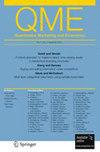How to generalize from a hierarchical model?
IF 1.1
4区 管理学
Q3 BUSINESS
引用次数: 6
Abstract
Models of consumer heterogeneity play a pivotal role in marketing and economics, specifically in random coefficient or mixed logit models for aggregate or individual data and in hierarchical Bayesian models of heterogeneity. In applications, the inferential target often pertains to a population beyond the sample of consumers providing the data. For example, optimal prices inferred from the model are expected to be optimal in the population and not just optimal in the observed, finite sample. The population model, random coefficients distribution, or heterogeneity distribution is the natural and correct basis for generalizations from the observed sample to the market. However, in many if not most applications standard heterogeneity models such as the multivariate normal, or its finite mixture generalization lack economic rationality because they support regions of the parameter space that contradict basic economic arguments. For example, such population distributions support positive price coefficients or preferences against fuel-efficiency in cars. Likely as a consequence, it is common practice in applied research to rely on the collection of individual level mean estimates of consumers as a representation of population preferences that often substantially reduce the support for parameters in violation of economic expectations. To overcome the choice between relying on a mis-specified heterogeneity distribution and the collection of individual level means that fail to measure heterogeneity consistently, we develop an approach that facilitates the formulation of more economically faithful heterogeneity distributions based on prior constraints. In the common situation where the heterogeneity distribution comprises both constrained and unconstrained coefficients (e.g., brand and price coefficients), the choice of subjective prior parameters is an unresolved challenge. As a solution to this problem, we propose a marginal-conditional decomposition that avoids the conflict between wanting to be more informative about constrained parameters and only weakly informative about unconstrained parameters. We show how to efficiently sample from the implied posterior and illustrate the merits of our prior as well as the drawbacks of relying on means of individual level preferences for decision-making in two illustrative case studies.如何从层次模型中进行推广?
消费者异质性模型在市场营销和经济学中发挥着关键作用,特别是在随机系数或混合logit模型中,用于汇总或个人数据,以及在分层贝叶斯异质性模型中。在应用程序中,推断目标通常属于提供数据的消费者样本之外的人群。例如,从模型推断出的最优价格在总体中是最优的,而不仅仅是在观察到的有限样本中是最优的。总体模型、随机系数分布或异质性分布是从观察样本到市场的自然和正确的基础。然而,在许多(如果不是大多数)应用中,标准异质性模型如多元正态或其有限混合泛化缺乏经济合理性,因为它们支持与基本经济论点相矛盾的参数空间区域。例如,这样的人口分布支持积极的价格系数或对汽车燃油效率的偏好。很可能的结果是,在应用研究中,通常的做法是依靠收集消费者的个人水平均值估计来代表人口偏好,这往往大大减少了对违反经济预期的参数的支持。为了克服依赖于错误指定的异质性分布和收集个人水平意味着无法一致地测量异质性之间的选择,我们开发了一种方法,有助于基于先验约束制定更经济上忠实的异质性分布。在异质性分布包括约束系数和非约束系数(如品牌系数和价格系数)的常见情况下,主观先验参数的选择是一个尚未解决的挑战。作为这个问题的解决方案,我们提出了一种边际条件分解,它避免了想要获得更多关于约束参数的信息和只想获得弱信息之间的冲突。在两个说明性的案例研究中,我们展示了如何有效地从隐含后验中取样,并说明了我们的先验的优点以及依赖于个人水平偏好的决策手段的缺点。
本文章由计算机程序翻译,如有差异,请以英文原文为准。
求助全文
约1分钟内获得全文
求助全文
来源期刊

Qme-Quantitative Marketing and Economics
Multiple-
CiteScore
2.30
自引率
10.50%
发文量
13
期刊介绍:
Quantitative Marketing and Economics (QME) publishes research in the intersection of Marketing, Economics and Statistics. Our focus is on important applied problems of relevance to marketing using a quantitative approach. We define marketing broadly as the study of the interface between firms, competitors and consumers. This includes but is not limited to consumer preferences, consumer demand and decision-making, strategic interaction of firms, pricing, promotion, targeting, product design/positioning, and channel issues. We embrace a wide variety of research methods including applied economic theory, econometrics and statistical methods. Empirical research using primary, secondary or experimental data is also encouraged. Officially cited as: Quant Mark Econ
 求助内容:
求助内容: 应助结果提醒方式:
应助结果提醒方式:


